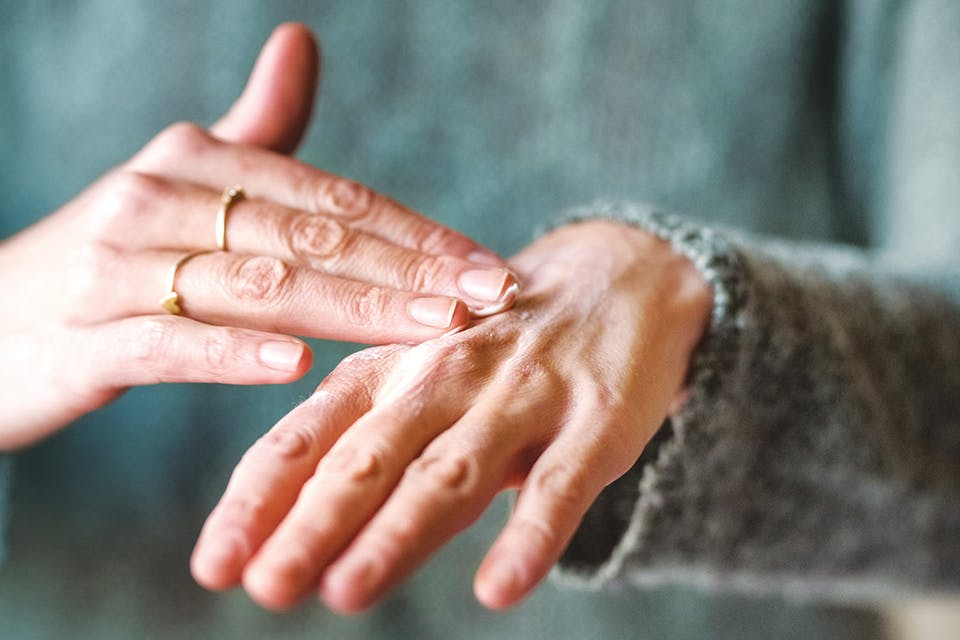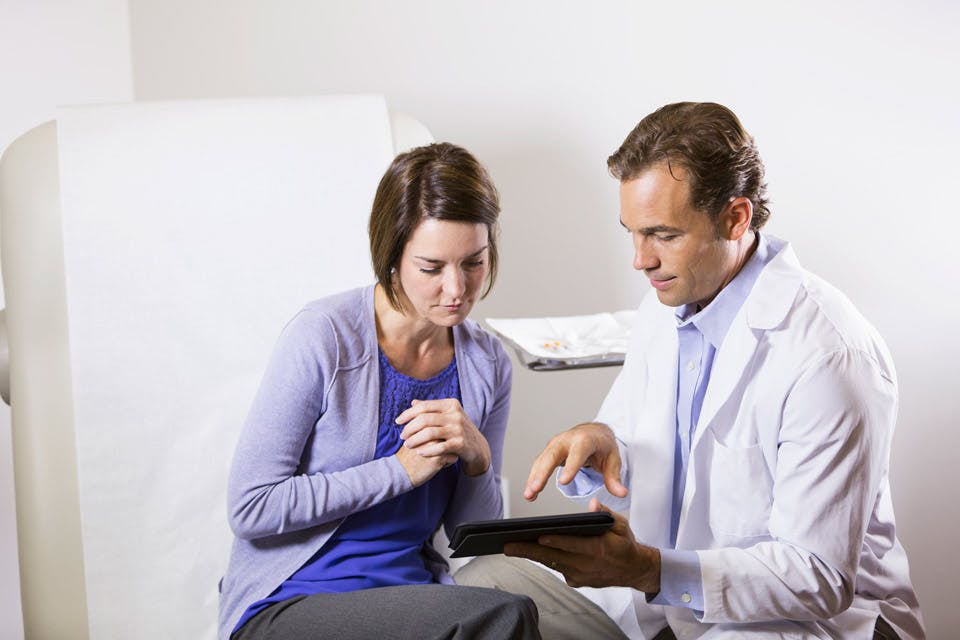Live Well Ohio: May 2016
Here's how to make the most of your doctor visits.
May 2016 Issue
BY Staff & Contributors | Photos by Istock
May 2016 Issue
BY Staff & Contributors | Photos by Istock
Care Plan
A doctor’s office can be intimidating. It’s also one of the rare moments when you have the undivided attention of someone who is an expert on the human body. The key is to be open, honest and an active participant in your healthcare. Here’s how to do just that.
It’s tough not to feel like a lab rat at the doctor’s office. Ignore the sterile setting, and it’s still easy to feel disoriented in a whirl of unfamiliar terminology, white coats and windowless rooms. But when it comes to health decisions, patients have power, even in a hospital gown. To claim a more active role in your personal care plan, there’s one place to begin: Start by finding your voice.
“Write down what worries you,” says Dr. Randy Wexler, a family physician at The Ohio State University Wexner Medical Center in Columbus. “When people get nervous and anxious, they tend to forget things.” They might bring up aches and pains outside of their main concern too, which can distract from underlying issues. “If they write it down, they’re much more likely to actually bring it up.”
Even with the advent of electronic medical records, it helps to bring along a written list of procedures you’ve had, any specialists you see and all medications you’re taking — and yes, that includes any over-the-counter supplements.
“People totally forget about their supplements,” says Dr. Melinda Ruff, a family physician with Dayton’s Premier Health network. “Sometimes they can be interacting with medications. It’s just important to know everything they’re on.”
Ruff also encourages patients to be honest about the way they’re taking their medication.
“Just because a doctor prescribed it to them doesn’t mean they’re taking it at all, or how they’re supposed to take it,” she says. But that’s not grounds for punishment. “We still need to know that you’re doing that. It’s not supposed to be punitive; it’s just saying, ‘This is how the person actually takes it,’ which is important information.”
This level of honesty on the part of the patient plays one of the most important roles in developing a strong patient-provider relationship. Being open helps doctors make better-informed diagnoses and write prescriptions that are likely to help. But doctors know that some issues are easier to talk about than others.
“Like Vegas, what’s said in the doctor’s office stays in the doctor’s office,” quips Dr. William Steiner, a community primary care physician with University Hospitals in Cleveland. “Sometimes with highly personal matters [patients] feel very intimidated talking to us, and that’s just human nature.”
That’s where confidence comes in. Approaching an office visit with a sense of self-assurance — even if it’s about a touchy subject — helps diffuse tension.
“If you feel comfortable with your physician, you would bring up those issues,” says Steiner. “Even if it means saying, ‘Well, doc, I feel a little bit embarrassed by this, but …’ ”
Additionally, Steiner notes, a good physician will encourage patients to speak up.
As a family physician, Wexler sees patients on both ends of the spectrum of divulgence. He says some of his younger patients are open about their health, even comfortable enough to discuss sexual health and drug use. However, he is quick to call out one important subject that is difficult for patients to broach across the board.
“When you have individuals who have been acculturated [to the stigma of] anxiety and depression … they won’t bring it up. A lot of people still believe they should just be able to get over it.”
Wexler is adamant, however, that people understand there’s no difference between mental and physical concerns.
“That becomes an important component for patients to understand,” he says. “There’s nothing you did or could have done. It’s just how it is.”
If the thought of asking a question about a tender subject causes anxiety, the age of electronic medical records presents another option.
“Patients can know more about their health than they have before,” says Ruff. “There are patient portals in most electronic health records now. You can put information on there that gets sent to your doctor. The next time the patient goes in, it’s there.”
Patient portals — essentially online accounts that allow patients to access their test results, keep track of past and upcoming appointments and manage scheduling — also offer people an opportunity to contact their providers through email to ask follow-up questions.
Although bringing concerns up in person is always preferable, the online feature can be a more comfortable outlet.
“I think the ability to do it through email seems less stressful for a lot of people,” says Wexler. “It’s a lot easier to write it down and hit the button than to look at me and say it, for some things.”
Having easier access to personal medical history has also allowed patients to be a more active participant in their health.
“It’s getting so cool,” says Ruff. “The amount of things that you, as a patient, are able to see and do as the most important part of your healthcare team.”
Having exam and test results at your fingertips within a few clicks does not, however, replace asking for what you need. For example, if there are a number of concerns you’d like to address, make sure to let the office know as you schedule an appointment.
“Many primary care physicians will have different lengths of appointments,” says Wexler. He also advocates prioritizing the things you’d like to talk about before coming into the office.
Ruff also suggests bringing along a partner or family member if there’s too much to remember or if an appointment is going to be particularly stressful.
“At those really important visits, bring someone,” she says. “Sometimes you do get information overload, so having that second set of ears — somebody to sit down and just take notes — can be really helpful.”
And before you leave the office, encourages Steiner, be sure to ask what comes next.
“It is perfectly fair [and] appropriate,” he says. “If they’re ready to leave and they don’t know what the next step is, they should ask the doctor or the staff, ‘How will I get my results, and in what kind of time frame?’ ”
No matter the reason for the visit or outcome of a test, Ruff says she hopes patients see their doctors as people they can collaborate with to meet their health goals.
“It is our job to tell you, ‘Here’s the things we need to work on.’ But that doesn’t mean that they’re telling you you’re a bad person,” she explains. “I have medicines in my arsenal, but I can’t go to your home, I can’t make you take them. I can’t make you choose a healthy plate. But I can cheer you on so that you can do those things for yourself. Because honestly, you are the most important part of your health.” — Frances Killea
***
Moving Forward
It’s easier said than done to make physical activity a regular part of your routine. We asked personal trainers across the state their advice for creating a plan that’s most likely to work.
Find a Support System: One of the first steps to making physical activity a priority is identifying a person or people who will hold you accountable for following through with this lifestyle change. Traditionally, that has taken the form of a workout buddy, but it goes beyond that. “We try to find out if they have friends who would like to work out with them, or get a family member who will just support them and their goal,” says Justin Thompson, lead fitness coach at TriHealth Fitness & Health Pavilion in Cincinnati. Identify people in your life who have the habits that you aspire to have and ask them to keep you on track. Thompson estimates that anywhere from 60 to 70 percent of inactivity relapse happens during a time of emotional distress, and it’s vital to have someone in your life who can encourage you past those moments. “Just gradually adding new friends and spending more time in a new environment that supports your goals can go a long way,” says Scott Crabiel, a personal training coordinator for Akron General Lifestyles. “When you have a good accountability system in place, it just enables you to do things consistently and it enables you to do them repetitively.”
Embrace Technology: Don’t rely solely on friends and family to hold you accountable. For an adviser who won’t go easy on you, turn to your smartphone. Once programmed, it simply will not overlook that you’re sitting on the couch rather than lacing up your walking shoes. Plan a time of day to work out, schedule those sessions on your phone and then program it to send you reminders. If you’re looking for more support, online communities can connect you with others trying to make similar changes. Bryan Williams, a personal trainer at ProMedica Wildwood Athletic Club in Toledo, suggests using the wealth of workout videos available on YouTube. He says a smartphone app that provides a specific workout plan is another good option. “MyFitnessPal is a great fitness app that we use for nutrition and fitness,” says Williams, adding that it allows users to create goals, log their exercise and access discussion forums. “It helps you stay accountable.”
Start Slow: People very often overextend themselves when they begin making physical activity a regular part of their lives. Thompson says it is critical that people are aware of what they can and cannot do and any limitations they may have when it comes to exercise. Your doctor can help identify these issues. “Unfortunately a lot of people try to do things they could 10 or 15 years ago,” Thompson says. “You might have an underlying health condition that you’re not sure about or you don’t know about.” People also try to do too much too fast. It is important to first establish a good habit and then gradually progress toward your ultimate goal. “We as human beings overestimate what we can accomplish in a short period of time,” Crabiel says, “but we also grossly underestimate what we can accomplish over the long haul.”
Set Short-Term Goals: Creating realistic and achievable goals creates an urgency that every workout counts. In order to get the most out of your increased physical activity, goals should be determined at the outset, according to Crabiel. “When you’re working toward something that is deeply important to you and you’re making forward progress ... you have a lot of energy,” he says. An effective way to apply this is to open up a calendar, identify a date in the near future that correlates with an event or activity, such as a wedding, and schedule your workouts with that goal in mind. Whether you’re hoping to lose a few pounds or just move more, Crabiel says such goal setting works. “The big motivator and the big driver is that you have something to look forward to,” he adds. “We as human beings like to master things, and we are highly motivated to grow and develop.”
Go Beyond the Gym: Look around your community for intramural sports teams to join or take advantage of the walking or biking paths at your local park. Those who have kids should also plan regular outdoor activities with them as a way to instill good habits. “Going on a walk, riding bikes, playing catch, throwing Frisbees, jumping on a trampoline,” Williams says, “it’s never too early to learn the importance of exercise.” — Carolyn Pippin
***
Myth Busters
As summer approaches, exposure to the sun’s rays increases along with the possibility of doing damage to your skin. We asked three Ohio doctors to address some of the common misconceptions surrounding skin cancer.
MYTH: I’ll know if I have skin cancer
People often won’t get screened for skin cancer because they think they’ll be able to tell if it’s present on their body. But Dr. Dawn Sammons, dermatology and residency program director at OhioHealth O’Bleness Hospital in Athens, says most skin cancer is asymptomatic. “[It] doesn’t itch, it doesn’t hurt, it doesn’t anything — and for most people, the biggest issue is they’re completely unaware,” Sammons says. Basal cell and squamous cell cancers start as a red or scaly spot on the skin. The third type of cancer, melanoma, can be a mole that’s changing or a new spot that appears.
MYTH: Tanning beds are safer than tanning outdoors
Dr. Joanne Jeter, associate professor of medicine specializing in genetics at The Ohio State University Comprehensive Cancer Center, says people often erroneously believe that using a tanning bed to get a base tan helps prevent skin cancer. But early exposure to tanning beds actually increases the risk for youths to develop skin cancer. Dr. Blessing Nollah, a medical oncologist and hematologist at the Lima Memorial Cancer Institute, cites an International Agency for Research on Cancer statistic from 2009 that reports there is a 75 percent increased chance for melanoma in those who first use tanning beds before the age of 30.
MYTH: I’m too young to get skin cancer
“The fastest-growing group of people to get [melanoma] is young women ages 15 to 29,” says Sammons. About one in 50 people in the United States will be affected with melanoma in their lifetime. Jeter says cases of melanoma do not routinely show in people during their 20s or 30s, but cases have been known to appear in children and those in their teens. “We know from the data that childhood burns do increase the risk of melanoma,” she says.
MYTH: I can’t die from skin cancer
Each year, about 10,000 people die from melanoma alone, not to mention other types of skin cancer. The number of melanoma cases per year has increased every single year over the past 30 years. “People think, Oh it’s not a big deal I’ll just have it cut out,” says Sammons. “But when it’s on your nose or around your eye or on your face somewhere, that can be traumatic.” Treatments for skin cancer include surgery, chemotherapy, aminotherapy and, in some circumstances, radiation. “Even with the treatments available, not everyone responds to therapy,” says Nollah. “So it doesn’t matter how old they are, they should examine their skin and protect their skin with sunscreen.” — CP
Related Articles

Live Well Jan./Feb. 2024
How to prevent common hazards in and around the home and cold weather arrives. Plus, Dublin resident Greg Ruf shares his work to bring awareness to a lesser-known heart condition. READ MORE >>

Live Well Ohio: Nov.-Dec. 2023
Follow these five strategies to help combat dry skin this winter, and learn the lifestyle modifications that can help those at risk for developing diabetes. READ MORE >>

Live Well Ohio: July/August 2023
The Ohio Department of Natural Resources offers advice for staying safe on Ohio’s inland lakes, and a doctor shares how to help protect the health of your brain. READ MORE >>


